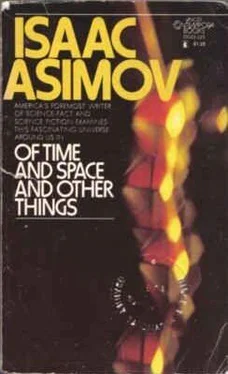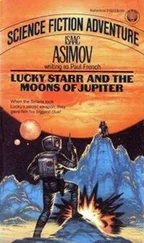Isaac Asimov - Of Time and Space and Other Things
Здесь есть возможность читать онлайн «Isaac Asimov - Of Time and Space and Other Things» весь текст электронной книги совершенно бесплатно (целиком полную версию без сокращений). В некоторых случаях можно слушать аудио, скачать через торрент в формате fb2 и присутствует краткое содержание. Год выпуска: 1972, ISBN: 1972, Издательство: Lancer Books, Жанр: Прочая научная литература, на английском языке. Описание произведения, (предисловие) а так же отзывы посетителей доступны на портале библиотеки ЛибКат.
- Название:Of Time and Space and Other Things
- Автор:
- Издательство:Lancer Books
- Жанр:
- Год:1972
- ISBN:ISBN: 0-447-33023-3
- Рейтинг книги:4 / 5. Голосов: 1
-
Избранное:Добавить в избранное
- Отзывы:
-
Ваша оценка:
- 80
- 1
- 2
- 3
- 4
- 5
Of Time and Space and Other Things: краткое содержание, описание и аннотация
Предлагаем к чтению аннотацию, описание, краткое содержание или предисловие (зависит от того, что написал сам автор книги «Of Time and Space and Other Things»). Если вы не нашли необходимую информацию о книге — напишите в комментариях, мы постараемся отыскать её.
Of Time and Space and Other Things — читать онлайн бесплатно полную книгу (весь текст) целиком
Ниже представлен текст книги, разбитый по страницам. Система сохранения места последней прочитанной страницы, позволяет с удобством читать онлайн бесплатно книгу «Of Time and Space and Other Things», без необходимости каждый раз заново искать на чём Вы остановились. Поставьте закладку, и сможете в любой момент перейти на страницу, на которой закончили чтение.
Интервал:
Закладка:
To be sure, under normal conditions there are no elec tron/positron systems in our surroundings, for positron virtually do not exist. Instead our universe (as far as we know) is held together electromagnetically by electron/ proton attractions. The proton is 1836 times as massive as the electron, so that the gravitational attraction is increased without a concomitant increase in electromagnetic attrac tion. In this case the ratio F,IF, is only 2.3 x 10il".
There are two other major forces in the physical world.
There is the nuclear strong interaction force which is over a hundred times as strong as even the electromagnetic force; and the nuclear weak interaction force, which is considerably weaker than the electromagnetic force. All three, however, are far, far strcinger than the gravitational force.
In fact, the force of gravity-though it is the first force with which we are acquainted, and though it is always with us, and though it is the one with a strength we most thoroughly appreciate-is by far the weakest known force in nature. It is first and rearmost!
What makes the gravitational force seem so strong?
First, the two nuclear forces;ire short-range forces which make themselves felt only over distances about the width of an atomic nucleus. The electromagnetic force and the gravitational force are the only two long-range forces.
Of these, the electromagnetic force cancels itself out (with slight and temporary local exceptions) because both an attraction and a repulsion exist.
This leaves gravitational force alone in the field.
What's more, the most conspicuous bodies in the uni verse happen to be conglomerations of vast mass, and we live on the surface of one of these conglomerations.
Even so, there are hints that give away the real weak ness of gravitational force. Your weak muscle can lift a fifty-pound weight with the whole mass of the earth pull ing, gravitationally, in the other direction. A to magnet will lift a pin against the entire counterpufl of the earth.
Oh, gravity is weak all right. But let's see if we can dramatize that weakness further.
Suppose that the Earth were an assemblage of nothing but its mass in positrons, while the Sun were an assem blage of nothing but its mass in electrons. The force of at traction between them would be vastly greater than the feeble gravitational force that holds them together now.
In fact, in order to reduce the electromagnetic attraction to no more than the present gravitational one, the Earth and Sun would have to be separated by some 33,000,000,000, 000,000 light-years, or about five million times the diame ter of the known universe.
Or suppose you imagined in the place of the Sun a mil 108 lion tons of electrons (equal to the mass of a very small asteroid). And in the place of the Earth, imagine 31/3 tons of positrons.
The electromagnetic attraction between these two in significant masses, separated by the distance from the Earth to the Sun, would be equal to the gravitational at traction between the colossal masses of those two bodies right now.
In fact, if one could scatter a million tons of electrons on the Sun, and 31/3 tons of positrons on the Earth, you would double the Sun's attraction for the Earth and alter the nature of Earth's orbit considerably. And if you made it electrons, both on Sun and Earth, so as to introduce a repulsion, you would cancel the gravitational attraction al together and send old Earth on its way out of the Solar System.
Of course, all this is just paper calculation. The mere fact that electromagnetic forces are as strong as they are means that you cannot collect a significant number of like charged particles in one place. They would repel each other too strongly.
Suppose you divided the Sun into marble-sized fragments and strewed them through the Solar System at mutual rest.
Could you, by some manmade device, keep those fragments from falling together under the pull of gravity? Well, this is no greater a task than that of getting bold of a million tons of electrons and squeezing them together into a ball.
The same would hold true if you tried to separate a sizable quantity of positive charge from a sizable quantity of negative charge.
If the universe were composed of electrons and posi trons as the chief charged particles, the electromagnetic force would make it necessary for them to come together.
Since they are anti-particles, one being the precise reverse of the other, they would melt together, cancel each other, and go up in one cosmic flare of gamma rays.
Fortunately, the universe is composed of electrons and protons as the chief charged particles. Tbough their charges are exact opposites (-I for the former and +1 for the latter), this is not so of other properties-such as mass, for instance. Electrons and protons are not antiparticles, in other words, and cannot cancel each other.
Their opposite charges, however, set up a strong mutual attraction that cannot, within limits, be gainsaid. An elec tron and ia proton therefore approach closely and then maintain themselves at a wary distance, forming the hy drogen atom.
Individual protons can cling together despite electro magnetic repulsion because of the existence of a very short-range nuclear strong interaction force that sets up an attraction between neighboring protons that far over balances the electromagnetic repulsion. This makes atoms other than hydrogen possible.
In short: nuclear forces dominate the atomic nucleus; electromagnetic forces dominate the atom itself; and grav itational forces dominate the large astronomic bodies.
The weakness of the gravitational force is a source of frustration to physicists.
The different forces, you see, make themselves felt by transfers of particles. The nuclear strong interaction force, the strongest of all, makes itself evident by transfers of pions (pi-mesons), while the electromagnetic force (next strongest) does it by the transfer of photons. An analogous particle involved in weak interactions (third strongest) has recently been reported. It is called the "W particle" and as yet the report is a tentative one.
So far, so good. It seems, then, that if gravitation is a force in the same sense that the others are, it should make itself evident by transfers of particles.
Physicists have given this particle a name, the "graviton."
They have even decided on its properties, or lack of prop erties. It is electrically neutral and without mass. (Because it is without mass, it must travel at an unvarying velocity, that of light.) It is stable, too; that is, left to itself, it Will not break down to form other particles.
So far, it is rather like the neutrino, [See Chapter 13 of my book View from a Height, Doubleday, 1963.] hich is also stable, electrically neutral, and massless (hence traveling at the velocity of light).
The graviton and the neutrino differ in some respects, however. The neutrino comes in two varieties, an electron neutrino and a muon (mu-meson) neutrino, each with its anti-particle; so there are, all told, four distinct kinds of neutrinos. The graviton comes in but one variety and is its own anti-particle. There is but one kind of graviton.
Then, too, the graviton has a spin of a type that is as signed the number 2, while the neutrino along with most other subatomic particles have spins of 1/2. (There are also some mesons with a spin of 0 and the photon with a spin of 1.)
The graviton has not yet been detected. It is even more elusive than the neutrino. The neutrino, while massless and chargeless, nevertheless has a measurable energy con tent. Its existence was first suspected, indeed, because it carried off enough energy to make a sizable gap in the bookkeeping.
But gravitons?
Well, remember that factor of 10421
An individual graviton must be trillions of trillions of trillions of times less energetic than a neutrino. Considering how difficult it was to detect the neutrino, the detection of the graviton is a problem that will really test the nuclear physicist.
Читать дальшеИнтервал:
Закладка:
Похожие книги на «Of Time and Space and Other Things»
Представляем Вашему вниманию похожие книги на «Of Time and Space and Other Things» списком для выбора. Мы отобрали схожую по названию и смыслу литературу в надежде предоставить читателям больше вариантов отыскать новые, интересные, ещё непрочитанные произведения.
Обсуждение, отзывы о книге «Of Time and Space and Other Things» и просто собственные мнения читателей. Оставьте ваши комментарии, напишите, что Вы думаете о произведении, его смысле или главных героях. Укажите что конкретно понравилось, а что нет, и почему Вы так считаете.












